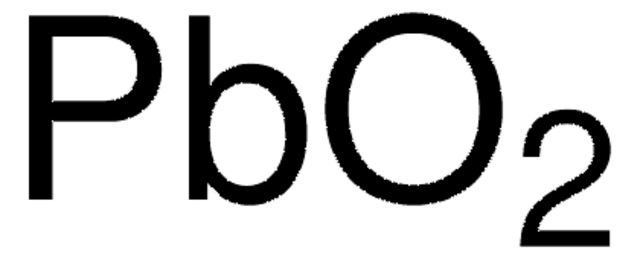203610
Lead(II) oxide
99.999% trace metals basis
Synonyme(s) :
Lead monoxide, Plumbous oxide
About This Item
Produits recommandés
Pression de vapeur
10 mmHg ( 0 °C)
Essai
99.999% trace metals basis
Forme
powder and chunks
Pertinence de la réaction
reagent type: catalyst
core: lead
Pf
886 °C (lit.)
Chaîne SMILES
O=[PbH2]
InChI
1S/O.Pb
Clé InChI
YEXPOXQUZXUXJW-UHFFFAOYSA-N
Vous recherchez des produits similaires ? Visite Guide de comparaison des produits
Description générale
Application
- Gamma ray radiation shielding glasses such as GeO2-PbO-Al2O3–CaO glasses.
- Perovskite ceramic materials. For example, it can be used to synthesize lead magnesium niobate, widely applied in the field of electronic ceramics due to its high dielectric constant and voltage stability.
Mention d'avertissement
Danger
Mentions de danger
Conseils de prudence
Classification des risques
Acute Tox. 4 Inhalation - Acute Tox. 4 Oral - Aquatic Acute 1 - Aquatic Chronic 1 - Carc. 2 - Lact. - Repr. 1A - STOT RE 1
Organes cibles
Central nervous system,Kidney,Blood
Code de la classe de stockage
6.1D - Non-combustible acute toxic Cat.3 / toxic hazardous materials or hazardous materials causing chronic effects
Classe de danger pour l'eau (WGK)
WGK 3
Point d'éclair (°F)
Not applicable
Point d'éclair (°C)
Not applicable
Équipement de protection individuelle
dust mask type N95 (US), Eyeshields, Gloves, type P2 (EN 143) respirator cartridges
Faites votre choix parmi les versions les plus récentes :
Certificats d'analyse (COA)
Vous ne trouvez pas la bonne version ?
Si vous avez besoin d'une version particulière, vous pouvez rechercher un certificat spécifique par le numéro de lot.
Déjà en possession de ce produit ?
Retrouvez la documentation relative aux produits que vous avez récemment achetés dans la Bibliothèque de documents.
Les clients ont également consulté
Notre équipe de scientifiques dispose d'une expérience dans tous les secteurs de la recherche, notamment en sciences de la vie, science des matériaux, synthèse chimique, chromatographie, analyse et dans de nombreux autres domaines..
Contacter notre Service technique












